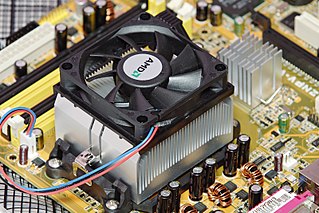
Fluorocarbons are chemical compounds with carbon-fluorine bonds. Compounds that contain many C-F bonds often have distinctive properties, e.g., enhanced stability, volatility, and hydrophobicity. Several fluorocarbons and their derivatives are commercial polymers, refrigerants, drugs, and anesthetics.

A refrigerant is a working fluid used in the refrigeration cycle of air conditioning systems and heat pumps where in most cases they undergo a repeated phase transition from a liquid to a gas and back again. Refrigerants are heavily regulated due to their toxicity, flammability and the contribution of CFC and HCFC refrigerants to ozone depletion and that of HFC refrigerants to climate change.

Computer cooling is required to remove the waste heat produced by computer components, to keep components within permissible operating temperature limits. Components that are susceptible to temporary malfunction or permanent failure if overheated include integrated circuits such as central processing units (CPUs), chipsets, graphics cards, hard disk drives, and solid state drives.
Difluoromethane, also called difluoromethylene, HFC-32Methylene Fluoride or R-32, is an organic compound of the dihalogenoalkane variety. It has the formula of CH2F2. It is a colorless gas in the ambient atmosphere and is slightly soluble in water, with a high thermal stability. Due to the low melting and boiling point, (-136.0 °C and -51.6 °C respectively) contact with this compound may result in frostbite. In the United States, the Clean Air Act Section 111 on Volatile Organic Compounds (VOC) has listed difluoromethane as an exception (since 1997) from the definition of VOC due to its low production of tropospheric ozone. Difluoromethane is commonly used in endothermic processes such as refrigeration or air conditioning.
Perfluoro(2-methyl-3-pentanone) is a fluorinated ketone with the structural formula CF3CF2C(=O)CF(CF3)2, a fully-fluorinated analog of ethyl isopropyl ketone. It is used as an electronics coolant liquid and fire protection fluid sold commercially by 3M under brand names such as Novec 1230, Novec 649, and FK-5-1-12. It is also known as “waterless water” or “dry water”.
A coolant is a substance, typically liquid, that is used to reduce or regulate the temperature of a system. An ideal coolant has high thermal capacity, low viscosity, is low-cost, non-toxic, chemically inert and neither causes nor promotes corrosion of the cooling system. Some applications also require the coolant to be an electrical insulator.

Chlorodifluoromethane or difluoromonochloromethane is a hydrochlorofluorocarbon (HCFC). This colorless gas is better known as HCFC-22, or R-22, or CHClF
2. It was commonly used as a propellant and refrigerant. These applications were phased out under the Montreal Protocol in developed countries in 2020 due to the compound's ozone depletion potential (ODP) and high global warming potential (GWP), and in developing countries this process will be completed by 2030. R-22 is a versatile intermediate in industrial organofluorine chemistry, e.g. as a precursor to tetrafluoroethylene.

Vapour-compression refrigeration or vapor-compression refrigeration system (VCRS), in which the refrigerant undergoes phase changes, is one of the many refrigeration cycles and is the most widely used method for air conditioning of buildings and automobiles. It is also used in domestic and commercial refrigerators, large-scale warehouses for chilled or frozen storage of foods and meats, refrigerated trucks and railroad cars, and a host of other commercial and industrial services. Oil refineries, petrochemical and chemical processing plants, and natural gas processing plants are among the many types of industrial plants that often utilize large vapor-compression refrigeration systems. Cascade refrigeration systems may also be implemented using two compressors.

Perfluorohexane, or tetradecafluorohexane, is a fluorocarbon. It is a derivative of hexane in which all the hydrogen atoms are replaced by fluorine atoms. It is used in one formulation of the electronic cooling liquid/insulator Fluorinert for low-temperature applications due to its low boiling point of 56 °C and freezing point of −90 °C. It is odorless and colorless. Unlike typical hydrocarbons, the structure features a helical carbon backbone.

FC-75 is a fluorocarbon derivative of tetrahydrofuran with the chemical formula C8F16O. It is practically insoluble in water.
Natural refrigerants are considered substances that serve as refrigerants in refrigeration systems. They are alternatives to synthetic refrigerants such as chlorofluorocarbon (CFC), hydrochlorofluorocarbon (HCFC), and hydrofluorocarbon (HFC) based refrigerants. Unlike other refrigerants, natural refrigerants can be found in nature and are commercially available thanks to physical industrial processes like fractional distillation, chemical reactions such as Haber process and spin-off gases. The most prominent of these include various natural hydrocarbons, carbon dioxide, ammonia, and water. Natural refrigerants are preferred actually in new equipment to their synthetic counterparts for their presumption of higher degrees of sustainability. With the current technologies available, almost 75 percent of the refrigeration and air conditioning sector has the potential to be converted to natural refrigerants.
Hydrofluoroethers (HFE) are a class of organic solvents. As non-ozone-depleting chemicals, they were developed originally as a replacement for CFCs, HFCs, HCFCs, and PFCs. They are typically colorless, odorless, tasteless, low toxicity, low viscosity, and liquid at room temperature. The boiling point of HFEs vary from 50 °C to nearly 100 °C. Although 3M first developed HFEs, other manufacturers have begun producing them.
A liquid dielectric is a dielectric material in liquid state. Its main purpose is to prevent or rapidly quench electric discharges. Dielectric liquids are used as electrical insulators in high voltage applications, e.g. transformers, capacitors, high voltage cables, and switchgear. Its function is to provide electrical insulation, suppress corona and arcing, and to serve as a coolant.

Hydrofluoroolefins (HFOs) are unsaturated organic compounds composed of hydrogen, fluorine and carbon. These organofluorine compounds are of interest as refrigerants. Unlike traditional hydrofluorocarbons (HFCs) and chlorofluorocarbons (CFCs), which are saturated, HFOs are olefins, otherwise known as alkenes.

trans-1,3,3,3-Tetrafluoropropene (HFO-1234ze(E), R-1234ze(E)) is a hydrofluoroolefin. It was developed as a "fourth generation" refrigerant to replace fluids such as R-134a, as a blowing agent for foam and aerosol applications, and in air horns and gas dusters. The use of R-134a is being phased out because of its high global warming potential (GWP). HFO-1234ze(E) itself has zero ozone-depletion potential (ODP=0), a very low global warming potential (GWP < 1 ), even lower than CO2, and it is classified by ANSI/ASHRAE as class A2L refrigerant (lower flammability and lower toxicity).
Fluorinated gases (F-gases) are a group of gases containing fluorine. They are divided into several types, the main of those are hydrofluorocarbons (HFCs), perfluorocarbons (PFCs), sulphur hexafluoride (SF6). They are used in refrigeration, air conditioning, heat pumps, fire suppression, electronics, aerospace, magnesium industry, foam and high voltage switchgear. As they are greenhouse gases with a strong global warming potential, their use is regulated.
In fluid thermodynamics, a heat transfer fluid is a gas or liquid that takes part in heat transfer by serving as an intermediary in cooling on one side of a process, transporting and storing thermal energy, and heating on another side of a process. Heat transfer fluids are used in countless applications and industrial processes requiring heating or cooling, typically in a closed circuit and in continuous cycles. Cooling water, for instance, cools an engine, while heating water in a hydronic heating system heats the radiator in a room.

Perfluorotributylamine (PFTBA), also referred to as FC43, is an organic compound with the chemical formula N(CF2CF2CF2CF3)3. It is a colorless liquid. A molecule of this chemical compound consists of three butyl groups connected to one nitrogen atom, in which all of the hydrogen atoms are replaced with fluorine atoms. The compound is produced for the electronics industry, along with other perfluoroalkylamines. The high degree of fluorination significantly reduces the basicity of the central amine due to electron-withdrawing effects.

Immersion cooling is an IT cooling practice by which complete servers are immersed in a dielectric, electrically non-conductive fluid that has significantly higher thermal conductivity than air. Heat is removed from a system by putting the coolant in direct contact with hot components, and circulating the heated liquid through heat exchangers. This practice is highly effective because liquid coolants can absorb more heat from the system, and are more easily circulated through the system, than air. Immersion cooling has many benefits, including but not limited to: sustainability, performance, reliability and cost

C4-FN (C4-fluoronitrile, C4FN) is a perfluorinated compound developed as a high-dielectric gas for high-voltage switchgear. It has the structure (CF3)2CFC≡N, which can be described as perfluoroisobutyronitrile, falling under the category of PFAS, or per- and polyfluoroalkyl substances.












